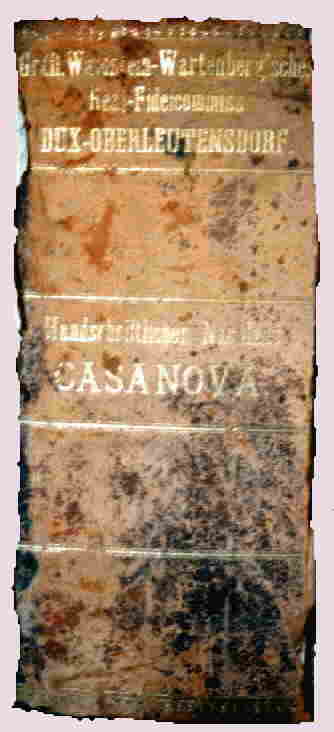
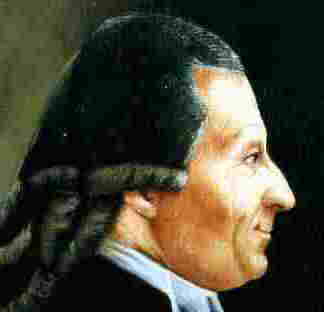

Documents from
Casanova's Heritage
and Small Talk
presented by
Marco Leeflang
Part III: (26.) The cruel creditors and the hostile wife of François Casanova - (25.) Casanova digs a canal... - (24.) Casanova's History of the Polish Turmoil - (23.) Laforgue was not the only one... - (22.) Old Casanova and the carnal act - (21.) A footnote by Casanova about La Pompadour. - (20.) A selfportrait of Manon Balletti!
........................................................................................................................................
Part II: (19.) The true Casanova and the ficticious professor. - (18.) Illusive Illustrations / en francais - (17.) Casanova, agent 002 (continuation) - (16.) Casanova Appointed Intelligence Agent 002 -(15.) A written portrait of Casanova - (14.) F... to Andrea Memmo (about Miss XCV) - (13.) Elise von der Recke / Madame Calvesi
........................................................................................................................................
Part I: (12.) Giacomo Casanova, notes for his memoirs - (11.) Calvesi - (10.) Teresa Casanova - (9.) Laurent Raghianti - (8.) Antonio Rossi - Giovanni B. Manuzzi : (7.) 17. Juli 1756 . (6.) 22. März 1756 - (5.) Mme de Rumbeke - (4.) Maria Rizzotti - Carlo Bollini: (3.) 1.8.1772 . (2.) 28.7.1772 - (1.) Carlo Angiolini . Descendance et vie.
It is 5 years ago that (a photocopy of) Casanova's manuscript of the Memoirs returned to Dux. For almost all of the 70 people who had come to Dux for the bicentenary commemoration of Casanova's death, it was a complete surprise, prepared by Hubertus Brockhaus, Josef Polisensky and me.
A few days earlier I had picked up, in Wiesbaden, the twelve large boxes each of which contained the very clear copies of one volume of the Histoire de ma vie.
In the magnificent reception hall of the Waldstein palace the boxes were stored underneath a white sheet with snacks op top of it. In his welcome speech the mayor of Dux, Jiry Nemec, finally gave away the secret Return of Casanova, took away the table-cover, and displayed the manuscript cases.
After everyone had had the chance to inspect the boxes and their contents, I handed the cases over to twelve of the participants, in order to escort them to their final destination: the Casanova library of the municipal museum.Here are 10 of the 12 deciples who took care of the final transfer to the museum, situated 100 meters away from the castle in the Masaryk street nr.7, where the copies are consultable to everyone who goes to Dux.
It is so easy to laugh about somebody elses mistakes, and so easy to make them yourself.
While working on the register of names in the total Casanova fund (the Duxionnaire 3) I was struck by the fact that quite a few people had died in april and without specification of the day. It turned out to be my own mistake. When I had found in the index to the Memoirs that somebody lived from, (for instance: 1725 - apr. 1797), I had read the abbreviation "apr" as "april", while it should have been "après (after)".
The damage is repaired in the meanwhile, but owners of a Duxionnaire 3, printed before 2001, will have to be careful!One of the early great casanovists, who has published many items from the Casanova heritage in Dux, is the Italian senator Pompeo Molmenti.
In his book, Carteggi Casanoviani (1916), he publishes (p.234) a letter from baron Pittoni to Casanova.
The two met in Triest in 1773 where Casanova was working hard on his return to Venice. They became good friends. Pittoni was chief of the police in Triest and amateur of litterature. He tried to find subscribers for Casanova's publications (the history of Poland, the translated Ilias, and the Opuscoli Miscellanei). After Giacomo's final departure from Venice there seems to have been a period of silence, but in 1789 Casanova revives the old friendship and writes a letter informing Pittoni of his recent experiences. Pittoni answers and a new exchange of letters has started.In one of these [Marr 10A3 d.d. 6 september 1791] Pittoni writes that he has been to Vienna where:

Molmenti prints:
Here a phantom is born.
Madame Irene emerges, and Molmenti suggests even a family name for the phantom: Irene Rinaldi.It all started with a false transcription of the original text by Vèze (a copy of which is to be found in the Childs archive in the university of Virginia). Vèze saw his mistake ("irene" and "frere" look very much alike in Pittoni's handwriting) and corrected it, but forgot to strike out Irene. Vèze sent the copy to Molmenti who printed it in too good faith and annotated it with too much phantasy.
Needless to say that in my Duxionnary 3 Irene Rinaldi died in "april 1790"!
Errors seldom come alone... Mine has been corrected in the meanwhile. That was easy.
Less easy it is to correct the phantom Rinaldi in the "Index des noms" of the Memoirs. You 'll have to do that yourselves. Both the Brockhaus and the Laffont edition have taken the phantom for a fact.In case you like to read the complete and interesting letter, here it is. I have corrected (printed in fat) some other errors as well.
à PadoueTrès cher ami,
à Monsieur
Monsieur Jacques Casanova
Toeplitz
en Bohème
Il faut des ordres des belles Dames pour vous faire souvenir des vos amis. Je leur dois donc reconnoissance très respectueuse du plaisir vraimant sensible qu'elles m'ont procurés en recevant votre chère lettre du 20 aout de Töplitz, à la quel je ne tarde pas de repondre.
L'Abbé Da Ponte se trouvait à Triest pendant que S.Mé. de retour de l'Italie est arrivé; il remarqua le dit abbé au Théatre avec étonnement, et avec douleur, il m'adressa la parole en me disant qu'il ne fallait pas le saluer, qu'il étoit un coquin et que par son ordre il a été chassé de Vienne.
Le gouverneur Ce de Brigido remontrà à S.Mé. qu'il étoit venu expressément à Trieste pour avoir audience de S.Mé. pour s'exculper sur différent griefs, qu'on le lui eut empêché. S.Mé. refusa tout net de le voir, il repliqua et confirma son premier ordre.
Le lendemain S.Mé. m'ordonna de faire venir l'abbé Da Ponte chez lui à 11 heures du matin; il y fut et il resta pendant une heure et demie; du discours je ne suis pas informé, mais le résultat fût une suspension d'user des rigueurs de la Police contre lui; Il se peut fort bien qu'[il] ait parlé des maquereaux, car c'est un affair de l'abbé et qui interesse la P.[= la Police?] Je ne doute pas même je ai lieu de croire, qu'il s'agissoit de decouvrir de fripons. Voilà tout ce que vs pouvez dire aux belles dames qui vs ont chargé, en leurs présentant mes très humbles respects.
J'ai été à Vienne, il y a un an, j'ai connu Mr Ve Frère, qui m'a comblé de bontés et d'amitiés; nous avons souvent parlé de vs.
Je suis à Padoue pour retablir ma santé delabrée. Mr Donà vs fait ses compliments et moi je vs embrasse.
Votre très humble serviteurPittoni Padoüe, ce 6 7bre 1791 [ Marr 10A3 ]
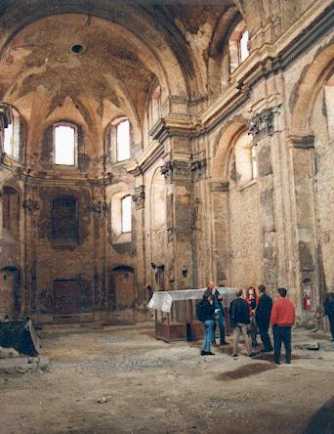 The church of Dux occupies a warm spot in my heart. Not only because Casanova
went to mass there, but also for its more recent history.
The church of Dux occupies a warm spot in my heart. Not only because Casanova
went to mass there, but also for its more recent history.
Let me start with December 1989. It
was on the steps of this church that the people of Dux assembled at night
to hear the news-bulletins of the "velvet revolution", being read aloud
in the light of an oil-lamp.
What did the government do in Prague? Which side was
the police on? How about the Russian troops? Who would take over in case
the communists would step down? Were there any guidelines for action in
Dux?
It seemed to me that the news of the French Revolution
would have spread in just about the same way.
The church looks well kept from the
outside; but the doors were locked permanentely.
It took till 1996, while preparing
the bicentennial of Casanova's death, that I managed to see the inside.
It made a theatrical impression. It
is a hall of emptyness...
In W.W.II the
Germans mounted anti-aircraft guns on the spires, and in 1945 the liberating
Russians had shot those on fire. The flames spread to the church and only
left the smoking walls. Lateron a new roof was made and the walls were
repaired and painted white and yellow. But it is only décor...
There is one black-and-white picture
of the inside, taken before the disaster. It shows the very baroque furniture
of the time Casanova lived in Dux. The architect, the italian Marc Antonio
Canevale, finished the church in 1707. For his principal he designed a
loge, from which the Waldsteins could attend mass (left side). The entrance
was on the first floor of the castle. The loge had windows and could be
heated.
Count Waldstein had allowed his main employees and Casanova to use it while he was away from Dux. Sometimes however people, who did not belong there, intruded the loge.
Lettre VII Il y a un oratoire dans le chateau de Dux, où il n'est permis d'aller entendre la Messe qu'au comte, et à ses premiers officiers. Les officiers de la garnison ont leur banc dans l'eglise. C'est là que je vais l'entendre parceque le comte m'a dit que c'est ma place. Viderol s'y etant introduit il y a deux ans, je l'ai dit au comte, et il lui a defendu d'y aller. Malgré cette defense je l'y ai trouvé il y a dix mois avec Caroline, qui quand elle y pense croit d'etre Lutherienne. En voyant ce couple je suis retourné sur mes pas, et je suis allé adorer l'Eucharistie dans l'eglise avec mes freres les paysans catholiques. Après cet eclat, Viderol se montra sur le banc dans l'enceinte du maître autel tenant un livre à la main pour faire croire au public qu'il sait lire. [Casanova, 1792, in Marr 39-1, VIIme lettre]

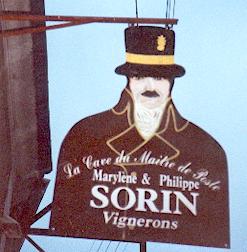
The postal road from Lyon to Paris via Auxerre (which Casanova travelled per diligence in June 1750) used to cross the river Yonne at Cravant (route marked in blue on the map).So, on the next trip through that region, my wife and I decided to have a look at St.Bris, and book a night and order a meal in the old Hôtel de la Poste if it still existed.But one day in 1730 the bridge at Cravant collapsed and the diligence was forced to make a detour, north of the river, via St.Bris.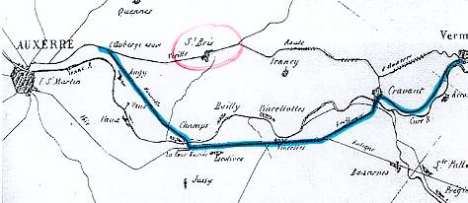
[map d.d. 1850]
After some time the bridge was reconstructed and eventually the diligence would have been able to resume its old route, but the passengers preferred to continue the detour.
They had discovered that the post station of St.Bris, on the alternative route, had a cellar and a cuisine of heavenly standing, incomparable with any competition in the neigbourhood.
It was not till 1846 that the postal route resumed its itinerary of 1730...
Nowadays it is the home of the winegrower Philippe Sorin whose family handed over the land and the art of wine making from father to son since 1577.. . .
It had been a post station and an inn till about 1870 when a notary bought the place and made it his home and office.. . .
Not much imagination is needed to see the place bristling with people and horses as it did in Casanova's time.
I promised another Document on the precarious financial situation of le Peintre du Roi, Francesco Casanova. Here it is. It is in Giacomo's handwriting and dates from october /november 1783, just before the departure (the flight) of the two brothers from Paris.
- et je suis d'autant plus pressé de finir cet ouvrage que je laisse 1200 florins à prendre au Sieur Fiquet Maitre de Danse en fait d'armes a Vienne - le quel est le frere de ce Sieur Fiquet boucher a Paris a qui je le dois et qui en a fait sa procuration a ce frere en question - [ Marr 9-50 ]But have a close look yourself at the full account of Francesco's (and his wife's) bad management.
Mr du Frenois
Il a promis à Mr Casanova de lui diminuer un tiers de sa dette personnelle. Cette dette donc ne monteroit plus qu'à la somme di 21144 #, selon la somme qui est sur le registre di 31716 # .
[Note: # means Franc / Livre; you can imagine: 1 Franc = 10 Euro. Cf here
"rates of exchange".]
de plus a remarquer:
Mr Casanova donne à prendre a M du Frenois la somme de 12000 # sur la manufacture, sur les quelles deduisant 600 # pour une opposition de du Verger il reste 11400 #.
de plus:
Il y a a rebattre 7000 # de deux grans tableaux avec leur bordure, que Mr du Frenois a cedé à Madame Sorin, et autres 3000 # d'un tableau que Madame Casanova lui a vendu elle meme.
Si le 31716 # ne sont point comptés avec le rabais de ces sommes, ce que Mr Casanova ignore, il se trouve que Mr Casanova est quitte avec M du Frenois avec une petite difference de 266 # a l'avantage de Casanova.
----------------------------------------------------------------
M Poulain
A la mort de M Poulain Me sa mere trouva des billets de Mr Casanova pour la somme de 17000 #. Madame Poulain a exigé qu'en paiement de cette somme Mr Casanova lui fasse quatre tableaux deux dans l'année 1784, les deux autres l'année 1785.
M Bourgeois de Cretienville
Celui ci est créancier de 6000 #, et c'est le premier des creanciers, qui sont a craindre pour M. Casanova, et que nous allons examiner.
//
M Bourgeois de Cretienville ....... 6000 #
Aux ouvriers de Franconville .................. 5600
A son orloger ............................ 1200
Au marchand de couleur ........................ 2300
Au bonnetier ......................................... 1200
........................................................... 16300Si Mr Casanova eut pu finir son grand tableau avant que de s'en aller, il en auroit exigé 24000 # qu'on ne peut pas lui refuser, des quelles rabattant 2400 # qu'il a reçu, il auroit touche 21600 #.
Voici la disposition qu'il auroit fait de cette somme
................................................................................................ a compte
A M. Bourgeois de Cretienville ........................................................ 3000
A son cuisinier ............................................................................... 2400
A François ..................................................................................... 2400
Pour retirer tout ce qui est en gage ................................................... 4000Aux ouvriers de Franconville .......................................................... 2400
Au bonnetier .................................................................................... 600
A Boutet tapissier pour decharger Mad. Casanova
de la moitié de son engagement ....................................................... 2000
A Artus Md de papier ........................................................................ 386
Au marbrier ...................................................................................... 250
Pour le faiseur de grillages .................................................................. 160
A son boucher ................................................................................... 400
Au marchand de bois oublié par Mad. ................................................. 400
A Mess. le Roux, et la Salle Mds d'etoffe, oublié par Mad. .................. 2000
A l'orloger ......................................................................................... 600
Au marchand de couleur .................................................................... 604
...................................................................................................... 21600
//
Dilucidation
La dette que Mr Casanova a avec François se monte comme il dit a la somme de 14000 environ, mais elle est sujette a des exeptions, les quelles consistent en ce qu'il y a 4800 # pour les quelles il s'est engagé de faire quatre paisages a 50 Louis piece. Il lui resteroit donc à lui paier environ 9000 #.
---
La dette de 8000 # a deux ouvriers doit être enregistrer a 10000 a un seul ouvrier; mais Mad. Casanova peut se rapeller que Mr Casanova a donné les preuves d'usure a M. Chenu, commissaire rue mazarine le quel lui a dit qu'aussitot, que les heritiers de Mr Poirlier lui presenteroient la lettre de change portant cette somme Mr Casanova n'auroit qu'a le conduire chez lui. Cette lettre n'a jamais paru.Pour ce que Mad. Casanova dit qu'elle devroit paier si elle restoit logée au Louvre , au serrurier. Le meme serrurier a dit a Mr Casanova qu'il ne vouloit en argent comptant que 160, et pour le surplus un tableau, et ceci fut dit en presence de Mr Vivier. Quand au doreur en fonte a qui il est du 360 #, il demande un petit tableau pour cette somme. [Marr 16 i 1]